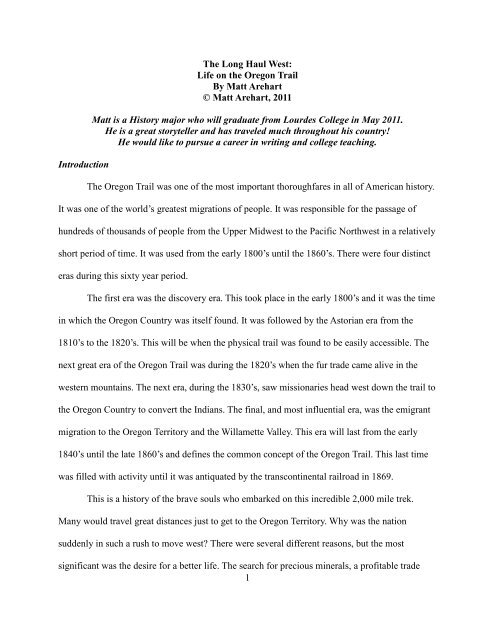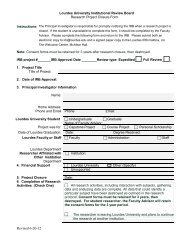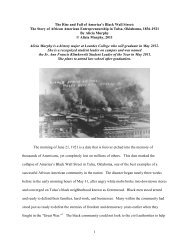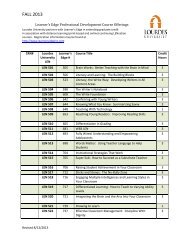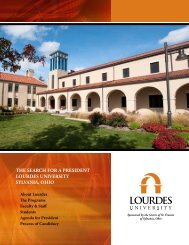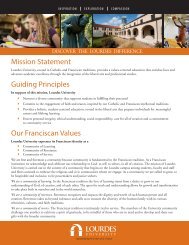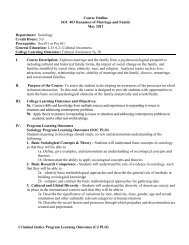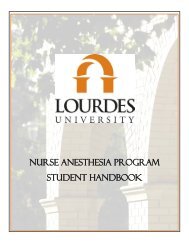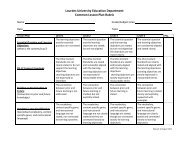The Long Haul West: Life on the Oregon Trail By ... - Lourdes College
The Long Haul West: Life on the Oregon Trail By ... - Lourdes College
The Long Haul West: Life on the Oregon Trail By ... - Lourdes College
Create successful ePaper yourself
Turn your PDF publications into a flip-book with our unique Google optimized e-Paper software.
Introducti<strong>on</strong><br />
<str<strong>on</strong>g>The</str<strong>on</strong>g> <str<strong>on</strong>g>L<strong>on</strong>g</str<strong>on</strong>g> <str<strong>on</strong>g>Haul</str<strong>on</strong>g> <str<strong>on</strong>g>West</str<strong>on</strong>g>:<br />
<str<strong>on</strong>g>Life</str<strong>on</strong>g> <strong>on</strong> <strong>the</strong> Oreg<strong>on</strong> <strong>Trail</strong><br />
<strong>By</strong> Matt Arehart<br />
© Matt Arehart, 2011<br />
Matt is a History major who will graduate from <strong>Lourdes</strong> <strong>College</strong> in May 2011.<br />
He is a great storyteller and has traveled much throughout his country!<br />
He would like to pursue a career in writing and college teaching.<br />
<str<strong>on</strong>g>The</str<strong>on</strong>g> Oreg<strong>on</strong> <strong>Trail</strong> was <strong>on</strong>e of <strong>the</strong> most important thoroughfares in all of American history.<br />
It was <strong>on</strong>e of <strong>the</strong> world’s greatest migrati<strong>on</strong>s of people. It was resp<strong>on</strong>sible for <strong>the</strong> passage of<br />
hundreds of thousands of people from <strong>the</strong> Upper Midwest to <strong>the</strong> Pacific Northwest in a relatively<br />
short period of time. It was used from <strong>the</strong> early 1800’s until <strong>the</strong> 1860’s. <str<strong>on</strong>g>The</str<strong>on</strong>g>re were four distinct<br />
eras during this sixty year period.<br />
<str<strong>on</strong>g>The</str<strong>on</strong>g> first era was <strong>the</strong> discovery era. This took place in <strong>the</strong> early 1800’s and it was <strong>the</strong> time<br />
in which <strong>the</strong> Oreg<strong>on</strong> Country was itself found. It was followed by <strong>the</strong> Astorian era from <strong>the</strong><br />
1810’s to <strong>the</strong> 1820’s. This will be when <strong>the</strong> physical trail was found to be easily accessible. <str<strong>on</strong>g>The</str<strong>on</strong>g><br />
next great era of <strong>the</strong> Oreg<strong>on</strong> <strong>Trail</strong> was during <strong>the</strong> 1820’s when <strong>the</strong> fur trade came alive in <strong>the</strong><br />
western mountains. <str<strong>on</strong>g>The</str<strong>on</strong>g> next era, during <strong>the</strong> 1830’s, saw missi<strong>on</strong>aries head west down <strong>the</strong> trail to<br />
<strong>the</strong> Oreg<strong>on</strong> Country to c<strong>on</strong>vert <strong>the</strong> Indians. <str<strong>on</strong>g>The</str<strong>on</strong>g> final, and most influential era, was <strong>the</strong> emigrant<br />
migrati<strong>on</strong> to <strong>the</strong> Oreg<strong>on</strong> Territory and <strong>the</strong> Willamette Valley. This era will last from <strong>the</strong> early<br />
1840’s until <strong>the</strong> late 1860’s and defines <strong>the</strong> comm<strong>on</strong> c<strong>on</strong>cept of <strong>the</strong> Oreg<strong>on</strong> <strong>Trail</strong>. This last time<br />
was filled with activity until it was antiquated by <strong>the</strong> transc<strong>on</strong>tinental railroad in 1869.<br />
This is a history of <strong>the</strong> brave souls who embarked <strong>on</strong> this incredible 2,000 mile trek.<br />
Many would travel great distances just to get to <strong>the</strong> Oreg<strong>on</strong> Territory. Why was <strong>the</strong> nati<strong>on</strong><br />
suddenly in such a rush to move west? <str<strong>on</strong>g>The</str<strong>on</strong>g>re were several different reas<strong>on</strong>s, but <strong>the</strong> most<br />
significant was <strong>the</strong> desire for a better life. <str<strong>on</strong>g>The</str<strong>on</strong>g> search for precious minerals, a profitable trade<br />
1
industry, escape from religious persecuti<strong>on</strong>, <strong>the</strong> desire for adventure and <strong>the</strong> need for rich farm<br />
land <strong>on</strong> which to live were all part of <strong>the</strong> American dream that drove people west down <strong>the</strong> l<strong>on</strong>g<br />
trail.<br />
<str<strong>on</strong>g>The</str<strong>on</strong>g> Oreg<strong>on</strong> <strong>Trail</strong> was known by many different names depending <strong>on</strong> who was traveling<br />
<strong>on</strong> it or where it went. During <strong>the</strong> Morm<strong>on</strong> migrati<strong>on</strong> to Utah, it was called <strong>the</strong> Morm<strong>on</strong> <strong>Trail</strong>,<br />
and it went to <strong>the</strong> Great Salt Lake. It was known as <strong>the</strong> California <strong>Trail</strong> during <strong>the</strong> Gold Rush<br />
when every man went out to make his fortune in California. It was called <strong>the</strong> Platte <strong>Trail</strong> because<br />
it went through <strong>the</strong> Platte River Basin, not a pleasant place to be. <str<strong>on</strong>g>The</str<strong>on</strong>g> Indians had a few names<br />
for it, too, like <strong>the</strong> Great Medicine Road of <strong>the</strong> Whites and <strong>the</strong> White-Topped Wag<strong>on</strong> Road. But<br />
history came to know it as <strong>the</strong> Oreg<strong>on</strong> <strong>Trail</strong>. 1<br />
To understand <strong>the</strong> Oreg<strong>on</strong> <strong>Trail</strong>, we must understand where exactly its path wove. <str<strong>on</strong>g>The</str<strong>on</strong>g><br />
2,000 mile path across <strong>the</strong> <str<strong>on</strong>g>West</str<strong>on</strong>g>ern United States began in Independence, Missouri and many<br />
similar cities al<strong>on</strong>g <strong>the</strong> Missouri River. This was near <strong>the</strong> border with Kansas al<strong>on</strong>g <strong>the</strong> Missouri<br />
River. From <strong>the</strong>re, <strong>the</strong> trail entered Kansas and took a turn north towards Nebraska. Once in<br />
Nebraska, <strong>the</strong> trail cut across <strong>the</strong> state diag<strong>on</strong>ally to <strong>the</strong> northwest. A third of <strong>the</strong> way into<br />
Nebraska, <strong>the</strong> trail met <strong>the</strong> Platte River at Fort Kearney. <str<strong>on</strong>g>The</str<strong>on</strong>g> trail followed <strong>the</strong> Platte River until<br />
it split into <strong>the</strong> North and South Platte Rivers. This was in Nebraska near <strong>the</strong> nor<strong>the</strong>astern most<br />
point where it met Colorado. It c<strong>on</strong>tinued <strong>on</strong>, following <strong>the</strong> North Platte River into Wyoming.<br />
Before leaving Wyoming, <strong>the</strong> trail passed through Scott's Bluffs, home to some of <strong>the</strong><br />
most famous rock formati<strong>on</strong>s in <strong>the</strong> country including Chimney Rock. Once far<strong>the</strong>r into<br />
Wyoming, <strong>the</strong> trail’s first stop was Fort Laramie. Half way through Wyoming, it would pass by<br />
Independence Rock before heading up <strong>the</strong> steep stretch to <strong>the</strong> South Pass. This is where <strong>the</strong><br />
Oreg<strong>on</strong> <strong>Trail</strong> crossed <strong>the</strong> Rocky Mountains, at <strong>the</strong> source of <strong>the</strong> North Platte River. Once through<br />
2
<strong>the</strong> pass, <strong>the</strong> trail crossed <strong>the</strong> Green River and headed a short way to Fort Bridger. From <strong>the</strong>re,<br />
<strong>the</strong> Morm<strong>on</strong> <strong>Trail</strong> broke off to <strong>the</strong> south, while <strong>the</strong> Oreg<strong>on</strong> <strong>Trail</strong> cut sharply to <strong>the</strong> north and<br />
entered Idaho. In Idaho, <strong>the</strong> emigrants would meet <strong>the</strong> Snake River, right where Fort Hall stood.<br />
At <strong>the</strong> fort, <strong>the</strong> trail split in two. <str<strong>on</strong>g>The</str<strong>on</strong>g> way to California went south while <strong>the</strong> way to Oreg<strong>on</strong><br />
followed <strong>the</strong> Snake all <strong>the</strong> way across Idaho. Fort Boise stood near <strong>the</strong> western end of Idaho.<br />
This was <strong>the</strong> last American fort <strong>on</strong> <strong>the</strong> Oreg<strong>on</strong> <strong>Trail</strong>. Past Fort Boise, <strong>the</strong> trail finally entered <strong>the</strong><br />
Oreg<strong>on</strong> Territory. It cut north to <strong>the</strong> Whitman Missi<strong>on</strong> and met <strong>the</strong> Columbia River. Once at <strong>the</strong><br />
Columbia, it was a boat ride west to <strong>the</strong> Promised Land. 2<br />
Discovery 1800's<br />
<str<strong>on</strong>g>The</str<strong>on</strong>g> first era can be named <strong>the</strong> “Era of Discovery.” In <strong>the</strong> year 1792 Captain Robert Gray<br />
was <strong>on</strong>e <strong>the</strong> first known white man to explore what would later be known as Oreg<strong>on</strong>. Gray took<br />
to <strong>the</strong> sea <strong>on</strong> a voyage and found <strong>the</strong> Columbia River. Gray’s discovery helped c<strong>on</strong>vince Thomas<br />
Jeffers<strong>on</strong> to buy <strong>the</strong> Louisiana territory in 1803. This purchase from France, secured for <strong>the</strong><br />
United States by M<strong>on</strong>roe and Livingst<strong>on</strong>, included New Orleans for ten milli<strong>on</strong> dollars and <strong>the</strong><br />
entire state of Louisiana for an additi<strong>on</strong>al five milli<strong>on</strong> dollars. 3 <str<strong>on</strong>g>The</str<strong>on</strong>g> great port city of New<br />
Orleans was highly valuable, positi<strong>on</strong>ed at <strong>the</strong> mouth of <strong>the</strong> Mississippi River. 4<br />
Jeffers<strong>on</strong> went <strong>on</strong> to commissi<strong>on</strong> Meriwe<strong>the</strong>r Lewis and William Clark to explore this<br />
new territory and, if at all possible, find a route to <strong>the</strong> Pacific through it. Lewis and Clark did not<br />
take <strong>the</strong> Oreg<strong>on</strong> <strong>Trail</strong> nor did <strong>the</strong>y start it. However, <strong>the</strong>ir reports about <strong>the</strong> American Northwest<br />
had <strong>the</strong> mouths of Americans watering for more land. <str<strong>on</strong>g>The</str<strong>on</strong>g> two men and <strong>the</strong>ir crew traveled all<br />
al<strong>on</strong>g <strong>the</strong> Missouri River and c<strong>on</strong>tinued <strong>on</strong> to <strong>the</strong> Pacific Ocean. Gun<strong>the</strong>r Barth, in his book <str<strong>on</strong>g>The</str<strong>on</strong>g><br />
Lewis and Clark Expediti<strong>on</strong>, said that Lewis and Clark took a mysterious area of <strong>the</strong> c<strong>on</strong>tinent<br />
and turned it into a tangible, reachable part of <strong>the</strong> c<strong>on</strong>tinent. 5 It is relevant, to <strong>the</strong> story of <strong>the</strong><br />
3
Oreg<strong>on</strong> <strong>Trail</strong>, to know how <strong>the</strong> first transc<strong>on</strong>tinental explorers travelled so that we may<br />
understand why every man in America did not jump west up<strong>on</strong> <strong>the</strong> news of <strong>the</strong> discovery.<br />
Patrick Gass was part of <strong>the</strong> expediti<strong>on</strong> and <strong>the</strong> first to publish a journal about <strong>the</strong> trip.<br />
His first entry described <strong>the</strong> expediti<strong>on</strong> <strong>on</strong> <strong>the</strong> 14 th of May 1804. <str<strong>on</strong>g>The</str<strong>on</strong>g>y began where many a<br />
pers<strong>on</strong> would begin <strong>the</strong> Oreg<strong>on</strong> <strong>Trail</strong>, near <strong>the</strong> Missouri river. <str<strong>on</strong>g>The</str<strong>on</strong>g> “corps” as Gass called it<br />
c<strong>on</strong>sisted of 43 men. <str<strong>on</strong>g>The</str<strong>on</strong>g>re were of course <strong>the</strong> two captains, Lewis and Clark. <str<strong>on</strong>g>The</str<strong>on</strong>g>n half of <strong>the</strong><br />
men bel<strong>on</strong>ged to <strong>the</strong> regular United States military and <strong>the</strong> o<strong>the</strong>r half were of various specialties<br />
for <strong>the</strong> specific journey ahead.<br />
This first expediti<strong>on</strong> west was very different than that of <strong>the</strong> later experiences but is still<br />
so important to <strong>the</strong> overall story. For <strong>the</strong>se first 43 men, <strong>the</strong> journey would be six times as l<strong>on</strong>g<br />
as <strong>the</strong> later trail blazers. <str<strong>on</strong>g>The</str<strong>on</strong>g>y would also take to <strong>the</strong> water as <strong>the</strong>ir means of transport. <str<strong>on</strong>g>The</str<strong>on</strong>g>y rode<br />
<strong>the</strong> river in what Gass called a batteau and two periogues. <str<strong>on</strong>g>The</str<strong>on</strong>g>se were boats that are specific to<br />
North America. 6<br />
Once <strong>the</strong> Lewis and Clark expediti<strong>on</strong> found <strong>the</strong> Oreg<strong>on</strong> Country, people would find it to<br />
difficult a trip to embark up<strong>on</strong> since it would take so l<strong>on</strong>g and be far too financially burdensome.<br />
So ends <strong>the</strong> era of discovery for <strong>the</strong> Oreg<strong>on</strong> <strong>Trail</strong>, at least for <strong>the</strong> time being.<br />
Astorians 1810's-1820's<br />
<str<strong>on</strong>g>The</str<strong>on</strong>g> birth of <strong>the</strong> actual Oreg<strong>on</strong> <strong>Trail</strong> would not come until <strong>the</strong> year 1812. Surprisingly it<br />
would not be found by pi<strong>on</strong>eers heading west, but by a group of fur traders fleeing eastward.<br />
This would all begin with a man named John Jacob Astor.<br />
Astor owned <strong>the</strong> American Fur Company that operated in <strong>the</strong> Oreg<strong>on</strong> Territory. This<br />
company came to be in <strong>the</strong> year 1808; two years after <strong>the</strong> Lewis and Clark expediti<strong>on</strong> explored<br />
<strong>the</strong> regi<strong>on</strong>. He had competiti<strong>on</strong> from <strong>the</strong> British fur companies in <strong>the</strong> area. This would <strong>on</strong>ly be a<br />
4
problem until Astor went to C<strong>on</strong>gress in 1816 and had an act passed that banned foreign traders<br />
from working <strong>on</strong> United States land. This would grant Astor <strong>the</strong> ability to run a m<strong>on</strong>opoly in <strong>the</strong><br />
Northwestern fur trade.<br />
In 1813 Astor founded a trading post in Oreg<strong>on</strong>; it was named Astoria after him. This<br />
trading post would change hands several times and end up in <strong>the</strong> hands of <strong>the</strong> British. It would<br />
stay this way until <strong>the</strong> 1840s. 7 Robert Stuart would be <strong>the</strong> first white man to take <strong>the</strong> Oreg<strong>on</strong><br />
<strong>Trail</strong>. Stuart, an American fur trader in Astoria, led a group of broken and rundown traders east<br />
<strong>on</strong> <strong>the</strong> trail back to safety. <str<strong>on</strong>g>The</str<strong>on</strong>g>y were fleeing from <strong>the</strong> British. <str<strong>on</strong>g>The</str<strong>on</strong>g> group left Astoria <strong>on</strong> <strong>the</strong><br />
Columbia River. <str<strong>on</strong>g>The</str<strong>on</strong>g>y would <strong>the</strong>n use <strong>the</strong> so<strong>on</strong> to be infamous South Pass through <strong>the</strong> Rocky<br />
Mountains. <str<strong>on</strong>g>The</str<strong>on</strong>g>y would return all <strong>the</strong> way back to <strong>the</strong> Missouri River. 8<br />
Later, mountain men of <strong>the</strong> northwest followed in <strong>the</strong> wake of Robert Stuart and his men.<br />
<str<strong>on</strong>g>The</str<strong>on</strong>g>y were <strong>the</strong> next to open up <strong>the</strong> south pass. <str<strong>on</strong>g>The</str<strong>on</strong>g>y would be led by a man named Jedediah<br />
Smith. <str<strong>on</strong>g>The</str<strong>on</strong>g> pass is rediscovered in 1824 and this time it would not be lost again. <str<strong>on</strong>g>The</str<strong>on</strong>g> mountain<br />
men were a very unique part of <strong>the</strong> culture of <strong>the</strong> Northwestern territories. <str<strong>on</strong>g>The</str<strong>on</strong>g>y are made up of<br />
two different groups, <strong>the</strong> miners and <strong>the</strong> trappers. <str<strong>on</strong>g>The</str<strong>on</strong>g>y for <strong>the</strong> most part lived off <strong>the</strong> land,<br />
without any type of civilizati<strong>on</strong>. <str<strong>on</strong>g>The</str<strong>on</strong>g>y followed <strong>the</strong> Oreg<strong>on</strong> <strong>Trail</strong> back to Missouri where <strong>the</strong>y<br />
sold <strong>the</strong>ir furs. 9<br />
<str<strong>on</strong>g>The</str<strong>on</strong>g> American mountain men were quite fascinating. <str<strong>on</strong>g>The</str<strong>on</strong>g>y would travel up into <strong>the</strong><br />
wilderness of <strong>the</strong> mountains and trap all year round. Once a year <strong>the</strong>y would come toge<strong>the</strong>r for<br />
<strong>the</strong> annual sale of <strong>the</strong>ir furs. This would be <strong>the</strong> <strong>on</strong>ly time that <strong>the</strong>se men would see ano<strong>the</strong>r white<br />
man, unless <strong>the</strong>y were to chance up<strong>on</strong> <strong>on</strong>e ano<strong>the</strong>r in <strong>the</strong> wilderness. At this ga<strong>the</strong>ring <strong>the</strong>y<br />
would sell <strong>the</strong>ir goods and be resupplied for ano<strong>the</strong>r year. <str<strong>on</strong>g>The</str<strong>on</strong>g>y would receive items such as<br />
“powder, lead, traps, tobacco, guns, knives, [and] hatchets.” 10<br />
5
Missi<strong>on</strong>aries 1830’s<br />
In <strong>the</strong> 1830s a Christian movement to save <strong>the</strong> Indians came about. <str<strong>on</strong>g>The</str<strong>on</strong>g>re were three<br />
main missi<strong>on</strong>s <strong>on</strong> <strong>the</strong> fr<strong>on</strong>tier. <str<strong>on</strong>g>The</str<strong>on</strong>g>y were <strong>the</strong> Tschimakains, Clear Water and Waiilatpu. 11<br />
From<br />
that movement came <strong>on</strong>e of <strong>the</strong> first waves of early western travelers. In 1863 Dr. Marcus<br />
Whitman, a Presbyterian missi<strong>on</strong>ary, and his wife Narcissa, headed to <strong>the</strong> Oreg<strong>on</strong> Territory. <str<strong>on</strong>g>The</str<strong>on</strong>g><br />
Whitmans would become <strong>the</strong> most important missi<strong>on</strong>aries to <strong>the</strong> history of <strong>the</strong> Oreg<strong>on</strong> <strong>Trail</strong>.<br />
<str<strong>on</strong>g>The</str<strong>on</strong>g>y set <strong>the</strong>ir missi<strong>on</strong> up in Walla-Walla and preached to <strong>the</strong> Cayuse Indians. <str<strong>on</strong>g>The</str<strong>on</strong>g>ir missi<strong>on</strong><br />
would also be an important stopping point for numerous bands of pi<strong>on</strong>eers up<strong>on</strong> arriving in <strong>the</strong><br />
territory. However, for all of <strong>the</strong>ir hard work and dedicati<strong>on</strong> to <strong>the</strong> Indians of <strong>the</strong> upper northwest<br />
<strong>the</strong>ir lives would end in tragedy. 12<br />
News of <strong>the</strong> Whitman massacre was forwarded to <strong>the</strong> American nati<strong>on</strong> and <strong>the</strong><br />
government of <strong>the</strong> United States by <strong>the</strong> Reverend William Roberts. He wrote that <strong>the</strong> Cayuse<br />
Indians had formed an alliance with <strong>the</strong> Walla Walla and <strong>the</strong> Nez Perce Indians to band against<br />
<strong>the</strong> white man. Many of <strong>the</strong> Indians had become gravely ill from <strong>the</strong> diseases that <strong>the</strong> white men<br />
brought and <strong>the</strong>y placed sole blame up<strong>on</strong> <strong>the</strong>m. While all that <strong>the</strong>y had wanted to do for <strong>the</strong><br />
Indians was help <strong>the</strong>m <strong>the</strong>y, Marcus and Narcissa, al<strong>on</strong>g with nine o<strong>the</strong>rs would lose <strong>the</strong>ir lives. 13<br />
Emigrants 1840's-1860's<br />
<str<strong>on</strong>g>The</str<strong>on</strong>g> Emigrant era was by far <strong>the</strong> most exciting time in <strong>the</strong> history of <strong>the</strong> Oreg<strong>on</strong> <strong>Trail</strong>.<br />
During this brief time period, hundreds of thousands of people made <strong>the</strong> trip west. <str<strong>on</strong>g>The</str<strong>on</strong>g>re were at<br />
least 500,000 people that made <strong>the</strong>ir way west by this route. During <strong>the</strong> busiest year in <strong>the</strong> trails<br />
history, 1852, over 70,000 embarked. Most of <strong>the</strong>se people were headed out west for <strong>the</strong> chance<br />
at rich fertile farm land.<br />
One of <strong>the</strong> best documented of <strong>the</strong> endeavors was taken by <strong>the</strong> Boatman party. It comes<br />
6
straight out of Mary Ann Richards<strong>on</strong>’s journals. <str<strong>on</strong>g>The</str<strong>on</strong>g> Boatmans, from Illinois, would head out in<br />
1852. <str<strong>on</strong>g>The</str<strong>on</strong>g>ir party c<strong>on</strong>sisted of Willis Boatman, age 24, and Mary Ann Richards<strong>on</strong>, age 18. <str<strong>on</strong>g>The</str<strong>on</strong>g>y<br />
were married October 14, 1851. Also, a bro<strong>the</strong>r of each came al<strong>on</strong>g; <strong>the</strong>y were John Boatman<br />
and William Richards<strong>on</strong>.<br />
<str<strong>on</strong>g>The</str<strong>on</strong>g>y departed <strong>on</strong> March 29, 1852. Mary Ann’s account of leaving was <strong>the</strong> typical<br />
reacti<strong>on</strong>. This was a huge adventure for such young adults and <strong>the</strong>y were nervous, anxious and<br />
sad to leave <strong>the</strong>ir families not knowing if <strong>the</strong>y would ever see <strong>on</strong>e ano<strong>the</strong>r again. One account<br />
from Ca<strong>the</strong>rine Scott Colburn recounts, every<strong>on</strong>e cried because <strong>the</strong>y would never see <strong>the</strong>ir<br />
families again. 14<br />
Before leaving it was necessary to make many preparati<strong>on</strong>s. Some of <strong>the</strong> items <strong>the</strong><br />
Boatmans list taking are “bedding, clothing, cooking utensils, provisi<strong>on</strong>s to last six m<strong>on</strong>ths [and]<br />
medicine.” 15 Ano<strong>the</strong>r emigrant, Joel Palmer, who left in 1845, made a much more detailed list of<br />
supplies. For food <strong>the</strong>y took; “200 [pounds] flour, 30 [pounds] pilot bread, 75 [pounds] bac<strong>on</strong>, 10<br />
[pounds] rice, 5 [pounds] coffee, 2 [pounds] of tea, 25 [pounds] sugar, half bushel of dried beans,<br />
1 bushel dried fruit, 10 [pounds] salt, ½ bushel cornmeal and [a] small keg of vinegar.” 16 Palmer<br />
also went into great detail <strong>on</strong> what sort of n<strong>on</strong>food items <strong>the</strong>y took with <strong>the</strong>m. He took a “sheet<br />
ir<strong>on</strong> stove, Dutch oven, cast metal skillet, tin plates, cups and saucers, two churns – <strong>on</strong>e for sweet<br />
– <strong>on</strong>e for sour milk, keg for water, tools – hand saw, plow molds, ax, shovel, rope, rifle and<br />
shotgun.” 17 This would have been c<strong>on</strong>sidered travelling light for <strong>the</strong> six m<strong>on</strong>th journey ahead of<br />
<strong>the</strong> emigrants.<br />
<str<strong>on</strong>g>The</str<strong>on</strong>g> Boatman party would be traveling in a wag<strong>on</strong> specifically engineered for this<br />
journey. <str<strong>on</strong>g>The</str<strong>on</strong>g>y had what was named a C<strong>on</strong>estoga which was <strong>the</strong> best of <strong>the</strong> best when it came to<br />
wag<strong>on</strong>s. <str<strong>on</strong>g>The</str<strong>on</strong>g> “wag<strong>on</strong> box…could be made water tight and used as a boat when fording<br />
7
streams” 18 This type of wag<strong>on</strong> was not typical of all <strong>the</strong> emigrants; most would just c<strong>on</strong>vert old<br />
wag<strong>on</strong>s from <strong>the</strong> farm. <str<strong>on</strong>g>The</str<strong>on</strong>g> beasts of choice to pull <strong>the</strong> wag<strong>on</strong>s were oxen. <str<strong>on</strong>g>The</str<strong>on</strong>g>y were more<br />
desirable than horses or cattle. Horses were not str<strong>on</strong>g enough to pull <strong>the</strong> heavy wag<strong>on</strong>s and<br />
cattle were too valuable to put through such rigors. <str<strong>on</strong>g>The</str<strong>on</strong>g> oxen were a bit slow but that was made<br />
up for by <strong>the</strong>ir durability. <str<strong>on</strong>g>The</str<strong>on</strong>g>y were also not highly sought after by <strong>the</strong> Indian thieves <strong>on</strong> <strong>the</strong> trail<br />
because <strong>the</strong>y served <strong>the</strong>m no good purpose. <str<strong>on</strong>g>The</str<strong>on</strong>g> oxen could live off of <strong>the</strong> land very easily; <strong>the</strong>y<br />
did not need <strong>the</strong> same type of grazing that <strong>the</strong> cattle did. 19<br />
Now that all <strong>the</strong> preparati<strong>on</strong>s had been made for <strong>the</strong> six m<strong>on</strong>th journey west, <strong>the</strong> emigrant<br />
would have been ready to head off. Most emigrants would signify starting <strong>the</strong> Oreg<strong>on</strong> <strong>Trail</strong> with<br />
<strong>the</strong> crossing of <strong>the</strong> Missouri River. This was d<strong>on</strong>e somewhere around Independence, Missouri.<br />
<str<strong>on</strong>g>The</str<strong>on</strong>g> Boatmans’ journey began <strong>on</strong> March 29, 1852 when <strong>the</strong>y left <strong>the</strong>ir lifel<strong>on</strong>g homes in Illinois.<br />
On <strong>the</strong>ir first day of travel, <strong>the</strong> Boatmans travelled 12 miles to meet up with ano<strong>the</strong>r party <strong>the</strong>y<br />
were to travel with. <str<strong>on</strong>g>The</str<strong>on</strong>g>se people were <strong>the</strong> Turners. Deac<strong>on</strong> Turner was a good friend of <strong>the</strong><br />
Boatman family and it was better to travel in larger numbers. <str<strong>on</strong>g>The</str<strong>on</strong>g> Boatmans would camp over<br />
night with <strong>the</strong> Turners before starting <strong>the</strong> journey all toge<strong>the</strong>r. As a whole this will add to <strong>the</strong><br />
Boatman party. 20<br />
<str<strong>on</strong>g>The</str<strong>on</strong>g> next day <strong>the</strong>y woke up at four in <strong>the</strong> morning to prepare to leave by ten. During this<br />
time, as was customary, a captain of <strong>the</strong> party was elected. In this case, Deac<strong>on</strong> Turner was<br />
elected. <str<strong>on</strong>g>The</str<strong>on</strong>g> complete party c<strong>on</strong>sisted of “18 people, 10 men, 5 women” 21 <str<strong>on</strong>g>The</str<strong>on</strong>g>y were <strong>the</strong> four in<br />
<strong>the</strong> original Boatman party, Deac<strong>on</strong> Turner and wife, <strong>the</strong>ir s<strong>on</strong> and his wife with two children,<br />
four hired hands, <strong>on</strong>e with a child. <str<strong>on</strong>g>The</str<strong>on</strong>g>re were five wag<strong>on</strong>s for <strong>the</strong> complete party. <str<strong>on</strong>g>The</str<strong>on</strong>g> wag<strong>on</strong><br />
trains were all different sizes, c<strong>on</strong>diti<strong>on</strong>al <strong>on</strong> how many people were going to go west. <str<strong>on</strong>g>The</str<strong>on</strong>g><br />
Bidwell-Bartles<strong>on</strong>, for example, c<strong>on</strong>sisted of “20 wag<strong>on</strong>s, 69 people.” 22<br />
8
While <strong>on</strong> <strong>the</strong> trail, <strong>the</strong> emigrants found all different ways to entertain <strong>the</strong>mselves. At<br />
night, <strong>the</strong> Boatman party would all come around <strong>the</strong> Deac<strong>on</strong>s fire and read <strong>the</strong> Bible and sing<br />
hymns. <str<strong>on</strong>g>The</str<strong>on</strong>g>y were very religious and even tried to observe <strong>the</strong> Sabbath when at all possible. This<br />
would become increasingly hard for <strong>the</strong> party to do later in <strong>the</strong> trip as <strong>the</strong>re might not always be<br />
an adequate place to camp <strong>on</strong> <strong>the</strong> Sabbath. It was mainly observed because it was not viewed as<br />
healthy for <strong>the</strong> people or <strong>the</strong> stock to travel for such l<strong>on</strong>g periods of time without rest. Mary Ann<br />
also c<strong>on</strong>sidered <strong>the</strong>m “wandering Israelites.” 23<br />
John Hawkins Clark of Cincinnati recalled his own forms of entertainment from his time<br />
<strong>on</strong> <strong>the</strong> Oreg<strong>on</strong> <strong>Trail</strong>. ”<str<strong>on</strong>g>The</str<strong>on</strong>g>re are many musicians bel<strong>on</strong>ging to <strong>the</strong> different encampments<br />
surrounding us, and after supper all commenced to practice <strong>the</strong> sweet tunes that were to enliven<br />
us while sitting around <strong>the</strong> camp fire…this c<strong>on</strong>cert lasted until near midnight.” 24<br />
<str<strong>on</strong>g>The</str<strong>on</strong>g> Boatman party reached <strong>the</strong> Missouri River around midday and <strong>the</strong>re were already<br />
hundreds of wag<strong>on</strong>s waiting to ferry <strong>the</strong> river. After signing up to cross, <strong>the</strong> Boatmans, would<br />
have to wait for over a week. At this time, <strong>the</strong> Boatman party got <strong>the</strong>ir first real look at <strong>the</strong> nature<br />
of <strong>the</strong> people <strong>the</strong>y were travelling with.<br />
On <strong>the</strong> first day of waiting to ferry <strong>the</strong> river, <strong>the</strong> party met with some of <strong>the</strong>ir neighbors.<br />
<str<strong>on</strong>g>The</str<strong>on</strong>g>se people told <strong>the</strong>m that it would be alright to let <strong>the</strong>ir cattle graze freely out <strong>on</strong> <strong>the</strong> field.<br />
Trustingly <strong>the</strong> Boatmans let <strong>the</strong>ir cattle go. While sleeping during that first night <strong>the</strong> men heard<br />
<strong>the</strong> cattle bells stir. So <strong>the</strong>y woke and went after <strong>the</strong>ir cattle. <str<strong>on</strong>g>The</str<strong>on</strong>g>y finally caught up with <strong>the</strong><br />
cattle five miles away in a swamp. It took a half day to free <strong>the</strong> cattle and bring <strong>the</strong>m back. It was<br />
clear to <strong>the</strong>m that <strong>the</strong> neighbors <strong>the</strong>y had trusted were deceitful with <strong>the</strong>m. After that <strong>the</strong>y<br />
decided to move camp away from <strong>the</strong>se neighbors. On <strong>the</strong>ir tenth day, <strong>the</strong>y were finally able to<br />
ferry across <strong>the</strong> Missouri River. It was <strong>the</strong> 20 th day of May. 25<br />
9
Mary Ann Boatman described ferrying across <strong>the</strong> river as a very slow process. <str<strong>on</strong>g>The</str<strong>on</strong>g><br />
endeavor took a c<strong>on</strong>siderable amount of man power. <str<strong>on</strong>g>The</str<strong>on</strong>g> emigrants ferried across <strong>on</strong> what was<br />
called a scow. A scow is a wooden raft big enough to hold two wag<strong>on</strong>s at a time. <str<strong>on</strong>g>The</str<strong>on</strong>g> mechanics<br />
of it was a rope fastened at ei<strong>the</strong>r side of <strong>the</strong> river and <strong>the</strong> scow was pulled across by <strong>the</strong> riders.<br />
<str<strong>on</strong>g>The</str<strong>on</strong>g>y also used pole and oars to assist in getting across. All of <strong>the</strong> livestock would have to swim<br />
across al<strong>on</strong>g side of <strong>the</strong> scow.<br />
Once <strong>the</strong> Boatmans had successfully crossed <strong>the</strong> Missouri River, <strong>the</strong>y camped in Omaha,<br />
Nebraska. <str<strong>on</strong>g>The</str<strong>on</strong>g>y had now officially left civilizati<strong>on</strong> behind <strong>the</strong>m for good. <str<strong>on</strong>g>The</str<strong>on</strong>g>y received a<br />
message from <strong>the</strong> emigrants up ahead <strong>on</strong> <strong>the</strong> trail that <strong>the</strong> Indians were dangerous and every<strong>on</strong>e<br />
should be traveling in large parties for <strong>the</strong>ir own protecti<strong>on</strong>. <str<strong>on</strong>g>The</str<strong>on</strong>g> Boatman party would join up<br />
with <strong>the</strong> Scott party for just this reas<strong>on</strong>. <str<strong>on</strong>g>The</str<strong>on</strong>g> Scott party was c<strong>on</strong>siderably larger than <strong>the</strong><br />
Boatman party and all toge<strong>the</strong>r <strong>the</strong>y made up a train of 30 wag<strong>on</strong>s. Deac<strong>on</strong> Turner would be<br />
chosen again as captain of this even larger party. Of all <strong>the</strong>se wag<strong>on</strong>s that combined to make this<br />
large Boatman-Scott party every man was armed and ready to fight. It was now <strong>the</strong> 22 nd of May<br />
and <strong>the</strong>y were ready to head out.<br />
<str<strong>on</strong>g>The</str<strong>on</strong>g> teams were very slow and, to keep <strong>the</strong> weight of <strong>the</strong> wag<strong>on</strong> low, <strong>the</strong> people walked<br />
al<strong>on</strong>g <strong>the</strong> wag<strong>on</strong>s. Some of <strong>the</strong> people <strong>on</strong> foot would go out ahead of <strong>the</strong> wag<strong>on</strong>s. <str<strong>on</strong>g>The</str<strong>on</strong>g>y would<br />
act as a scout looking for reas<strong>on</strong>able places to feed and water <strong>the</strong>ir teams. <str<strong>on</strong>g>The</str<strong>on</strong>g>y would also scout<br />
for places to camp for <strong>the</strong> night. As so<strong>on</strong> as a suitable place to stop was found <strong>the</strong> wag<strong>on</strong>s would<br />
all pull into a circle and form a protected little city. Once this mobile city was made for <strong>the</strong> night,<br />
every<strong>on</strong>e would have to work. <str<strong>on</strong>g>The</str<strong>on</strong>g> typical jobs included, but were not limited to, building fires,<br />
collecting water, setting up camp, guarding <strong>the</strong> cattle or making dinner.<br />
<str<strong>on</strong>g>The</str<strong>on</strong>g> Boatman-Scott party so<strong>on</strong> had <strong>the</strong>ir first encounter with <strong>the</strong> Indians. This encounter<br />
10
with <strong>the</strong> Indians would be typical of every encounter <strong>the</strong> party would have. During <strong>the</strong> evening<br />
hours, a small band of Indians rode up to <strong>the</strong> camp. When <strong>the</strong> emigrants heard <strong>the</strong>m coming<br />
toward <strong>the</strong> camp every<strong>on</strong>e became quite terrified. However, <strong>the</strong> Indians meant no trouble; <strong>the</strong>y<br />
had <strong>on</strong>ly come by to beg some food off of <strong>the</strong> settlers. <str<strong>on</strong>g>The</str<strong>on</strong>g> emigrants out of fear of c<strong>on</strong>sequence<br />
fed <strong>the</strong> Indians. Regardless of <strong>the</strong> hostility of <strong>the</strong> natives, <strong>the</strong> party awoke early in <strong>the</strong> morning,<br />
ate a quick breakfast and was back <strong>on</strong> <strong>the</strong> trail making distance between <strong>the</strong>mselves and <strong>the</strong><br />
Indians. 26<br />
A m<strong>on</strong>th would go <strong>on</strong> with no menti<strong>on</strong>able disturbances for <strong>the</strong> Boatman-Scott party.<br />
That was until <strong>the</strong>y came to Sand Hill Plain. This area was mostly flat with small mounds all<br />
around. <str<strong>on</strong>g>The</str<strong>on</strong>g> feed for <strong>the</strong> animals was still plentiful and <strong>the</strong>re was an adequate amount of water<br />
nearby. <str<strong>on</strong>g>The</str<strong>on</strong>g>re was also still a good supply of fuel for building fires. On <strong>the</strong> down side, this is<br />
where <strong>the</strong>y also encountered <strong>the</strong>ir first mosquitoes. <str<strong>on</strong>g>The</str<strong>on</strong>g> mosquitoes came in thick clouds. <str<strong>on</strong>g>The</str<strong>on</strong>g>y<br />
were so dense that “<strong>on</strong>e had to close <strong>the</strong>ir mouth to keep from having it filled.” 27<br />
<str<strong>on</strong>g>The</str<strong>on</strong>g> Boatman-Scott party travelled for two or three days. Mary Ann Boatman<br />
remembered how odd it was that <strong>the</strong>y had not seen an Indian for this amount of time. Ano<strong>the</strong>r<br />
peculiar thing about <strong>the</strong> Sand Hill Plain was that <strong>the</strong>re was a very foul odor. <str<strong>on</strong>g>The</str<strong>on</strong>g>y would so<strong>on</strong><br />
discover <strong>the</strong> reas<strong>on</strong> for both <strong>the</strong> lack of Indians and <strong>the</strong> foul odor. 28 <str<strong>on</strong>g>The</str<strong>on</strong>g> lack of Indians was not<br />
specific to Mary Ann’s account. James Clyman in 1844 also shared <strong>the</strong> same Phenomen<strong>on</strong>. “<str<strong>on</strong>g>The</str<strong>on</strong>g><br />
emigrants did not see any Indians <strong>on</strong> <strong>on</strong>e l<strong>on</strong>g stretch of <strong>the</strong> trail: from <strong>the</strong> point at which <strong>the</strong><br />
trains reached <strong>the</strong> Platte at Grande Island to <strong>the</strong> vicinity of Ft. Laramie.” 29<br />
On May 31, some<strong>on</strong>e scouting ahead found a suitable place to camp for <strong>the</strong> day. All was<br />
well here and <strong>the</strong>y had camp set up by four in <strong>the</strong> afterno<strong>on</strong>. While <strong>the</strong>y were camped <strong>the</strong>re, a<br />
herd of elk came by <strong>the</strong>m. Every man in camp likely shot at <strong>the</strong> elk but n<strong>on</strong>e were brought down.<br />
11
This was a great disappointment to <strong>the</strong> emigrants as <strong>the</strong>y had not had fresh meat since <strong>the</strong>y left<br />
home.<br />
After <strong>the</strong> emigrants had eaten dinner, <strong>the</strong> women went wandering off. <str<strong>on</strong>g>The</str<strong>on</strong>g>y decided to<br />
investigate <strong>the</strong> mounds that littered <strong>the</strong> plains <strong>the</strong>y were travelling. Up<strong>on</strong> looking inside of <strong>the</strong><br />
mounds, to <strong>the</strong>ir surprise, <strong>the</strong> women discovered that <strong>the</strong> remains of dead Indians had been<br />
shoved into <strong>the</strong> hollowed out mounds. This was <strong>the</strong> main factor in why <strong>the</strong>re was such a foul<br />
odor <strong>on</strong> <strong>the</strong> plain, many of <strong>the</strong> mounds were crammed full with Indian remains. 30 Ahead <strong>on</strong> <strong>the</strong><br />
trail <strong>the</strong> party would see many mass emigrant graves as well. <str<strong>on</strong>g>The</str<strong>on</strong>g> graves were marked and filled<br />
by <strong>the</strong> dreaded disease cholera. This factor would explain why <strong>the</strong>re were no more Indians<br />
around this area, besides <strong>the</strong> obvious that <strong>the</strong>y were all filled in <strong>the</strong> ground. 31<br />
So<strong>on</strong> it was obvious that something was terribly wr<strong>on</strong>g with <strong>the</strong> Boatman-Scott party. It<br />
was so<strong>on</strong> all over camp that Deac<strong>on</strong> Turner had c<strong>on</strong>tracted cholera. <str<strong>on</strong>g>The</str<strong>on</strong>g> captain was sick. He was<br />
“sitting in his chair…moaning aloud.” 32 Every man and woman did what <strong>the</strong>y could to help <strong>the</strong><br />
Deac<strong>on</strong> get better. Alas, all of <strong>the</strong>ir efforts were for naught, because Deac<strong>on</strong> Turner was dead by<br />
nine <strong>the</strong> next morning. <str<strong>on</strong>g>The</str<strong>on</strong>g> camp decided that he deserved a coffin for a proper burial. <str<strong>on</strong>g>The</str<strong>on</strong>g><br />
bottom to his wag<strong>on</strong> was torn out and crafted into a coffin and he was buried. 33<br />
Death would become a comm<strong>on</strong> thing after this point <strong>on</strong> <strong>the</strong> trail. Several parties would<br />
experience great amounts of death. Three separate accounts stand out from Tricia Wagner’s book.<br />
<str<strong>on</strong>g>The</str<strong>on</strong>g> first was a party who while burying six deceased souls, lost ano<strong>the</strong>r six members of <strong>the</strong>ir<br />
party. Ano<strong>the</strong>r wag<strong>on</strong> train reported losing a family of seven in <strong>on</strong>e night. <str<strong>on</strong>g>The</str<strong>on</strong>g> third, and most<br />
significant loss of life, came in a two day stretch when a wag<strong>on</strong> party lost forty members. <str<strong>on</strong>g>The</str<strong>on</strong>g>se<br />
may seem like drastic accounts but to <strong>the</strong> mid-nineteenth century pi<strong>on</strong>eer this would have been<br />
<strong>the</strong> norm. 34<br />
12
<str<strong>on</strong>g>The</str<strong>on</strong>g> Boatman party stayed at <strong>the</strong> grave of Deac<strong>on</strong> Turner until mid afterno<strong>on</strong> mourning<br />
<strong>the</strong> late Deac<strong>on</strong> Turner. It was decided that <strong>the</strong>y would move away from <strong>the</strong> place of such<br />
sickness and sorrow. <strong>By</strong> that same evening, it was apparent that Mary Ann’s bro<strong>the</strong>r William<br />
Richards<strong>on</strong> was sick. Again <strong>the</strong>y did what <strong>the</strong>y could for him. <str<strong>on</strong>g>The</str<strong>on</strong>g>y laid hot clo<strong>the</strong>s over him and<br />
surrounded him by hot st<strong>on</strong>es. For all of <strong>the</strong>ir effort with William success was achieved. He<br />
began to feel better by <strong>the</strong> morning. William was young and healthy for <strong>the</strong> most part. For this<br />
reas<strong>on</strong>, cholera did not have quite <strong>the</strong> same result as it had for Deac<strong>on</strong> Turner. Whe<strong>the</strong>r he was<br />
well enough to walk was of no matter because he was made to lay in <strong>the</strong> wag<strong>on</strong> when <strong>the</strong> train<br />
moved <strong>on</strong> for <strong>the</strong> day.<br />
<strong>By</strong> <strong>the</strong> end of <strong>the</strong> day when <strong>the</strong> Boatman-Scott party had come for a rest that night,<br />
William Richards<strong>on</strong> was feeling much better. However, that same night <strong>the</strong> youngest Turner<br />
youth was stricken with cholera and a huge storm moved in over <strong>the</strong> camp. <str<strong>on</strong>g>The</str<strong>on</strong>g> storm was so<br />
violent that trees were being ripped out of <strong>the</strong> ground and Mary Ann compared it to <strong>the</strong> force of a<br />
hurricane. <strong>By</strong> <strong>the</strong> next morning, <strong>the</strong> storm had subsided but <strong>the</strong> Turner boy was even worse for<br />
<strong>the</strong> wear. He would eventually die <strong>on</strong> that day. Again his coffin was c<strong>on</strong>structed and he was laid<br />
to rest. Again <strong>the</strong> camp was moved away from <strong>the</strong> site where <strong>the</strong> tragedy had occurred. 35<br />
On <strong>the</strong> same morning of <strong>the</strong> day <strong>the</strong> young Turner boy died, so too did an old woman die.<br />
<str<strong>on</strong>g>The</str<strong>on</strong>g> woman insisted she would be alright and that <strong>the</strong> camp should move <strong>on</strong> with her in a wag<strong>on</strong>.<br />
<strong>By</strong> <strong>the</strong> time <strong>the</strong> party stopped for no<strong>on</strong> she was dead. Now <strong>the</strong> floor of Mary Ann’s wag<strong>on</strong> was<br />
taken for <strong>the</strong> coffin and <strong>the</strong> old woman was buried. Once again <strong>the</strong> party moved <strong>on</strong> and camped<br />
somewhere else.<br />
<strong>By</strong> <strong>the</strong> time <strong>the</strong> midnight guard duty came in that night, <strong>the</strong> <strong>on</strong>ly remaining male Turner<br />
was too sick to go out for his shift of guard duty. <strong>By</strong> <strong>the</strong> morning he was dead and <strong>the</strong>y buried<br />
13
him. Now all of <strong>the</strong> male Turners, save for <strong>on</strong>e young <strong>on</strong>e, were dead. At this point, <strong>the</strong> Scott half<br />
of <strong>the</strong> Boatman-Scott party decided that <strong>the</strong>y were going to leave <strong>the</strong> o<strong>the</strong>rs and head <strong>on</strong> al<strong>on</strong>e.<br />
<str<strong>on</strong>g>The</str<strong>on</strong>g>y left <strong>the</strong>m so as not to c<strong>on</strong>tract cholera as it was highly c<strong>on</strong>tagious. <str<strong>on</strong>g>The</str<strong>on</strong>g> Boatman half stayed<br />
around for an extra day while <strong>the</strong> surviving Turners decided what <strong>the</strong>y would do. <str<strong>on</strong>g>The</str<strong>on</strong>g>y finally<br />
decided to head back east and try to c<strong>on</strong>solidate <strong>the</strong>ir losses. 36<br />
Now <strong>the</strong> Boatman party was back to its original size up<strong>on</strong> leaving home, plus <strong>on</strong>e. Mr.<br />
Warner, <strong>on</strong>e of <strong>the</strong> Turners hired men, wanted to c<strong>on</strong>tinue <strong>on</strong>. <str<strong>on</strong>g>The</str<strong>on</strong>g>y camped all al<strong>on</strong>e that night<br />
feeling depressed and ostracized. <str<strong>on</strong>g>The</str<strong>on</strong>g> next day <strong>the</strong>y woke early, drove hard all day and went late<br />
into <strong>the</strong> night. That night a big black wolf was seen scouting <strong>the</strong> small Boatman party. <str<strong>on</strong>g>The</str<strong>on</strong>g>y<br />
drove <strong>the</strong> next day without incident. <str<strong>on</strong>g>The</str<strong>on</strong>g>y were travelling very light now and were able to make<br />
great distances in a short amount of time. This makes plenty of sense seeing as that <strong>the</strong>y were all<br />
young and able bodied. This trend went <strong>on</strong> for a couple of weeks. One morning up<strong>on</strong> waking,<br />
Willis Boatman, Mary Ann’s husband, found his bro<strong>the</strong>r-in-law William stark raving mad. He<br />
was naked except for his undergarments and he was soaking wet from freezing cold water. He<br />
had apparently been trying to drive <strong>the</strong> oxen to <strong>the</strong> water throughout <strong>the</strong> night. At this point,<br />
every<strong>on</strong>e realized that William was very sick. Again <strong>the</strong> group did all that it could and tried to<br />
help bro<strong>the</strong>r William recovers from what ailed him. <str<strong>on</strong>g>The</str<strong>on</strong>g>y were at least able to calm him and he<br />
was able to leave <strong>the</strong> world with dignity. On that day William brea<strong>the</strong>d his last breath. 37<br />
It had been two m<strong>on</strong>ths and thirteen days since <strong>the</strong> Boatman party had left Iowa. <str<strong>on</strong>g>The</str<strong>on</strong>g>y<br />
were now <strong>on</strong>e short and had seen several unnerving deaths far too close to home. In Alcove<br />
Springs, Kansas, 110 miles west of Gardner, <strong>the</strong>re was, and still is today, a mass grave of over<br />
two-hundred known graves. This is relatively close to how far al<strong>on</strong>g <strong>the</strong> Boatmans were in <strong>the</strong>ir<br />
journey. It is put into perspective how tough <strong>the</strong> trail was that so many people were dead so so<strong>on</strong><br />
14
<strong>on</strong> <strong>the</strong> trail. 38<br />
<str<strong>on</strong>g>The</str<strong>on</strong>g> Boatman party c<strong>on</strong>tinued <strong>on</strong>, starting early and ending late. <str<strong>on</strong>g>The</str<strong>on</strong>g>y c<strong>on</strong>tinued to push<br />
like this all in hopes that <strong>the</strong>y would be able to catch up to <strong>the</strong> Scott party. Within a week <strong>the</strong>y<br />
would come up<strong>on</strong> Mr. Scott’s party. <str<strong>on</strong>g>The</str<strong>on</strong>g>y most likely were in such a hurry to meet up with <strong>the</strong><br />
Scotts because Mary Ann had become close with Mrs. Scott and her daughter. Mary Ann was<br />
young by most standards and needed female compani<strong>on</strong>ship. Also, it is believed that she was<br />
pregnant and would have needed a woman to help her give birth.<br />
<str<strong>on</strong>g>The</str<strong>on</strong>g> reunited Boatman-Scott party had now made it to <strong>the</strong> Platte River. Many people died<br />
al<strong>on</strong>g <strong>the</strong> Platte. <str<strong>on</strong>g>The</str<strong>on</strong>g>y would pass graves by <strong>the</strong> dozens. One train that <strong>the</strong>y passed had just<br />
finished burying six dead and ano<strong>the</strong>r six had died during <strong>the</strong> time it took to bury <strong>the</strong> first six.<br />
Ano<strong>the</strong>r said that <strong>the</strong>y had just finished burying a family of seven. Yet ano<strong>the</strong>r said forty had<br />
died within two nights and a day. Death was an everyday factor al<strong>on</strong>g <strong>the</strong> trail.<br />
Now <strong>the</strong> emigrants would ran into ano<strong>the</strong>r big problem. So many emigrants had g<strong>on</strong>e<br />
before <strong>the</strong>m and let <strong>the</strong>ir cattle and stock graze <strong>on</strong> all <strong>the</strong> lands grass. Now <strong>the</strong>y faced <strong>the</strong><br />
problem that all of <strong>the</strong> grass had been c<strong>on</strong>sumed or destroyed. <str<strong>on</strong>g>The</str<strong>on</strong>g>y would have to go great<br />
distances at night with <strong>the</strong>ir stock to find anywhere for <strong>the</strong>m to graze. 39 After several weeks of<br />
trudging westward in this manner, <strong>the</strong>y saw <strong>the</strong> first Indians <strong>the</strong>y had seen since <strong>the</strong> cholera<br />
outbreak. This would be both a blessing and a curse. For <strong>the</strong> most part it meant that <strong>the</strong> cholera<br />
epidemic was over with and <strong>on</strong> <strong>the</strong> o<strong>the</strong>r hand it meant that <strong>the</strong> troublesome Indians were back<br />
and <strong>the</strong>y would have to be <strong>on</strong> <strong>the</strong> watch for <strong>the</strong>m. <str<strong>on</strong>g>The</str<strong>on</strong>g> Indians told <strong>the</strong> Boatmans that <strong>the</strong>re was a<br />
bridge ahead that <strong>the</strong>y would have to cross. Of course <strong>the</strong> Indians said that <strong>the</strong>y would need to<br />
pay <strong>the</strong>m. <str<strong>on</strong>g>The</str<strong>on</strong>g> Boatmans refused payment until <strong>the</strong> time of service. This turned out to be a good<br />
thing, because <strong>the</strong> bridge had been built by white men and could be crossed freely. <str<strong>on</strong>g>The</str<strong>on</strong>g> bridge<br />
15
was built of timber and was <strong>the</strong>re because of a quicksand creek.<br />
That night when <strong>the</strong>y were camped al<strong>on</strong>g <strong>the</strong> trail a group of 20 Indians came to <strong>the</strong>m<br />
begging for supper. <str<strong>on</strong>g>The</str<strong>on</strong>g> emigrants were scared of repercussi<strong>on</strong>s so <strong>the</strong>y fed <strong>the</strong>m. More Indians<br />
came <strong>the</strong> next morning while <strong>the</strong>y were preparing breakfast and also begged a meal. <str<strong>on</strong>g>The</str<strong>on</strong>g><br />
emigrants short <strong>on</strong> supplies had to turn <strong>the</strong>m away. When <strong>the</strong> Boatman-Scott party went to head<br />
out for <strong>the</strong> day, <strong>the</strong>y noticed that <strong>on</strong>e of <strong>the</strong> better cows had come up missing. When <strong>the</strong> men<br />
went to look for it, <strong>the</strong>y found <strong>the</strong> cow with two Indians. <str<strong>on</strong>g>The</str<strong>on</strong>g> Indians had stolen <strong>the</strong> cow in<br />
return for not being fed. <str<strong>on</strong>g>The</str<strong>on</strong>g> men were able to trade for <strong>the</strong> cow and <strong>the</strong> party moved <strong>on</strong>. 40<br />
For about a m<strong>on</strong>th <strong>the</strong>y went <strong>on</strong> with no problems until <strong>on</strong>e of <strong>the</strong> older men got sick.<br />
<str<strong>on</strong>g>The</str<strong>on</strong>g> group could not decide what to do and <strong>the</strong> man demanded that <strong>the</strong>y move <strong>on</strong> and he would<br />
ride in <strong>the</strong> wag<strong>on</strong>. He was dead at no<strong>on</strong> when <strong>the</strong>y checked <strong>on</strong> him. However, fortune would<br />
hold out and this would be <strong>the</strong> last time <strong>the</strong>y saw death am<strong>on</strong>g <strong>the</strong>ir own until <strong>the</strong>y got to <strong>the</strong><br />
Oreg<strong>on</strong> Territory. <str<strong>on</strong>g>The</str<strong>on</strong>g>y were now at Fort Laramie. 41 Once <strong>the</strong> Boatman-Scott party had left Fort<br />
Laramie, <strong>the</strong>y headed al<strong>on</strong>g <strong>the</strong> Platte River until its end. At <strong>the</strong> end of <strong>the</strong> river was going to be<br />
<strong>on</strong>e of <strong>the</strong> hardest legs of <strong>the</strong> trip, <strong>the</strong> Great American Desert. <str<strong>on</strong>g>The</str<strong>on</strong>g> initial stretch of waterless<br />
desert was a fifty mile trek. <str<strong>on</strong>g>The</str<strong>on</strong>g>y would now have no more wood for fuel and <strong>the</strong>y would have to<br />
use buffalo chips for <strong>the</strong>ir fires. <str<strong>on</strong>g>The</str<strong>on</strong>g>y would also have to bake bread in <strong>the</strong> morning to last all<br />
day as <strong>the</strong>y would not be able to stop much. 42<br />
After this fifty mile stretch of desert, <strong>the</strong> party came up<strong>on</strong> <strong>the</strong> Sweetwater River. <str<strong>on</strong>g>The</str<strong>on</strong>g>y<br />
forded <strong>the</strong> river and camped <strong>on</strong> <strong>the</strong> o<strong>the</strong>r side. This was a great camping site to come into out of<br />
<strong>the</strong> desert. <str<strong>on</strong>g>The</str<strong>on</strong>g>re was fresh water, plenty of food for <strong>the</strong>ir stock to graze up<strong>on</strong> and <strong>the</strong>re was<br />
plenty of fuel. <str<strong>on</strong>g>The</str<strong>on</strong>g> people spent <strong>the</strong>ir time here lounging and playing. <str<strong>on</strong>g>The</str<strong>on</strong>g> name of this place was<br />
Devil’s Gate. When <strong>the</strong>y woke <strong>the</strong> next morning <strong>the</strong>y were very refreshed, had breakfast, and<br />
16
filled up every c<strong>on</strong>tainer <strong>the</strong>y had with water and left very early. From here it was 90 miles to <strong>the</strong><br />
South Pass. 43<br />
<str<strong>on</strong>g>The</str<strong>on</strong>g> Boatman-Scott party began up <strong>the</strong> Sweetwater Mountains. <str<strong>on</strong>g>The</str<strong>on</strong>g>se would lead <strong>the</strong><br />
group into <strong>the</strong> South Pass. Here in <strong>the</strong> South Pass water was very scarce. Just to get to it was a 3<br />
mile walk down hill and <strong>the</strong>n back uphill. At <strong>the</strong> top of <strong>the</strong> summit <strong>the</strong>re was snow <strong>the</strong> women all<br />
had a snow ball fight. <str<strong>on</strong>g>The</str<strong>on</strong>g>y <strong>the</strong>n began <strong>the</strong>ir trip down from <strong>the</strong> summit. It took careful driving<br />
but <strong>the</strong>y made it down without any trouble. <str<strong>on</strong>g>The</str<strong>on</strong>g>y stopped near <strong>the</strong> bottom at a campsite named<br />
Pacific Springs. This was a very good site because <strong>the</strong>re was fresh water and plenty of fuel here.<br />
Now a big decisi<strong>on</strong> was ahead of <strong>the</strong> party. <str<strong>on</strong>g>The</str<strong>on</strong>g>re was a fork in <strong>the</strong> road named <strong>the</strong> Parting of <strong>the</strong><br />
Ways. One route, <strong>the</strong> easier route, led to Fort Bridger but was way out of <strong>the</strong> way. <str<strong>on</strong>g>The</str<strong>on</strong>g> o<strong>the</strong>r<br />
route, named Sublette’s cutoff, was a tough <strong>on</strong>e hundred mile journey over rugged desert. <str<strong>on</strong>g>The</str<strong>on</strong>g><br />
Boatman-Scott party decided that <strong>the</strong>y should take <strong>the</strong> latter route to save time. 44<br />
At this point <strong>the</strong> emigrants we are following had come to Big Sandy Ford <strong>on</strong> <strong>the</strong> Green<br />
River. It is so named Big Sandy because <strong>the</strong> crossing was completely quick sand except for <strong>on</strong>e<br />
spot where it was safe to cross. <str<strong>on</strong>g>The</str<strong>on</strong>g> <strong>on</strong>ly challenge was finding where this safe spot was. So to<br />
find <strong>the</strong> safe spot a man would go <strong>on</strong> horseback and find <strong>the</strong> crossing. Once found <strong>the</strong> teams<br />
would be taken across <strong>on</strong>e at a time. <str<strong>on</strong>g>The</str<strong>on</strong>g> team would go up from <strong>the</strong> spot <strong>on</strong>e hundred yards and<br />
<strong>the</strong>n charge full speed across. <str<strong>on</strong>g>The</str<strong>on</strong>g> entire process took two hours. After this crossing <strong>the</strong>re was<br />
ano<strong>the</strong>r fifty miles of desert.<br />
<str<strong>on</strong>g>The</str<strong>on</strong>g> cattle were now fed and as much water as could be drank was stored and carried<br />
away. This was important because <strong>the</strong>re would be absolutely no water for <strong>the</strong> next fifty miles.<br />
After this <strong>the</strong>y departed. Every<strong>on</strong>e walked <strong>on</strong> this part of <strong>the</strong> voyage. Most of those people<br />
walking also carried c<strong>on</strong>tainers of water. <str<strong>on</strong>g>The</str<strong>on</strong>g>y travelled all day and all night for this stretch of<br />
17
<strong>the</strong> journey. <str<strong>on</strong>g>The</str<strong>on</strong>g>y would stop for dinner and <strong>the</strong>n c<strong>on</strong>tinue <strong>on</strong>. This was all well and good until<br />
<strong>on</strong>e of <strong>the</strong> wag<strong>on</strong>s flipped. This was caused by a combinati<strong>on</strong> of restless ox and a sleeping<br />
driver. 45 Wag<strong>on</strong> accidents were quite comm<strong>on</strong> <strong>on</strong> <strong>the</strong> 2,000 mile journey west. <str<strong>on</strong>g>The</str<strong>on</strong>g>y were made of<br />
wood; many were make shift from item found around <strong>the</strong> farm. John Clark recounts a story he<br />
heard al<strong>on</strong>g <strong>the</strong> trail of a gruesome accident. On June 18 th of 1852 he came up<strong>on</strong> an old woman<br />
walking behind her wag<strong>on</strong>. When he greeted her he did not expect <strong>the</strong> resp<strong>on</strong>se he got. She<br />
replied to him “<strong>on</strong>e of my grandchildren fell out of <strong>the</strong> wag<strong>on</strong> yesterday and both wheels ran<br />
plum over his head; oh dear! I shall never forget yesterday!” 46 While trying to c<strong>on</strong>sole <strong>the</strong><br />
woman <strong>on</strong> her loss he was shocked to discover that <strong>the</strong> child was still alive.<br />
<str<strong>on</strong>g>The</str<strong>on</strong>g>y took <strong>the</strong> wag<strong>on</strong> flip as a good sign to stop for <strong>the</strong> night. When <strong>the</strong>y woke <strong>the</strong>y had a<br />
quick breakfast and were off again. <strong>By</strong> three in <strong>the</strong> afterno<strong>on</strong> <strong>the</strong> cattle began to sniff <strong>the</strong> air and<br />
it was apparent to <strong>the</strong> emigrants that <strong>the</strong> beasts smelled water. A scout was sent out and sure<br />
enough <strong>the</strong> loop back of <strong>the</strong> Green River was <strong>on</strong>ly two miles ahead. However, before <strong>the</strong> fresh<br />
water could be reached, <strong>the</strong>re was a pois<strong>on</strong>ous alkali pool ahead. <str<strong>on</strong>g>The</str<strong>on</strong>g>re was a problem presented<br />
with this. <str<strong>on</strong>g>The</str<strong>on</strong>g> stock not knowing that this was pois<strong>on</strong>ous would surely want a drink of <strong>the</strong> water.<br />
So all of <strong>the</strong> men went ahead to guard <strong>the</strong> pool from <strong>the</strong> stock. Only two of <strong>the</strong> oxen drank from<br />
<strong>the</strong> pool. One got laid up for a week from it and <strong>the</strong> o<strong>the</strong>r died. 47<br />
<str<strong>on</strong>g>The</str<strong>on</strong>g>y finally made it past <strong>the</strong> desert to <strong>the</strong> Green River. <str<strong>on</strong>g>The</str<strong>on</strong>g>y would now have to prepare<br />
to ford <strong>the</strong> Green River <strong>on</strong>ce more. This would be <strong>the</strong> most difficult ford of <strong>the</strong> journey for <strong>the</strong><br />
Boatman-Scott party. It was too deep for <strong>the</strong> oxen to touch bottom and extremely swift. <str<strong>on</strong>g>The</str<strong>on</strong>g><br />
Boatmans would be <strong>the</strong> first to cross. About halfway across <strong>the</strong> ox started to get swept<br />
downstream. John had to jump out and swim with <strong>the</strong> team leading <strong>the</strong>m in <strong>the</strong> correct directi<strong>on</strong>.<br />
18
Mary Ann said this of <strong>the</strong> river, “<strong>the</strong> water was so swift it washed John’s pants and socks off.” 48<br />
In any case <strong>the</strong>y made it across with no real harm and <strong>the</strong>y camped <strong>the</strong>re a day. 49<br />
Here where <strong>the</strong>y camped <strong>the</strong>y came across a note, near three fresh graves, that read; “we<br />
a company of emigrants of five wag<strong>on</strong>s called a halt here yesterday no<strong>on</strong> finding a man about<br />
forty years, woman about thirty-five, with fr<strong>on</strong>t teeth filled with gold , [something] around her<br />
neck, been dragged down to waters edg[e]. a boy about ten years old all have <strong>the</strong>ir throats cut<br />
from ear to ear. Advising all that coming to be <strong>on</strong> <strong>the</strong> look out for Indians.” 50 <str<strong>on</strong>g>The</str<strong>on</strong>g>y moved <strong>on</strong><br />
from that spot quickly and drove <strong>on</strong> throughout <strong>the</strong> night until midnight. <str<strong>on</strong>g>The</str<strong>on</strong>g>y would have<br />
c<strong>on</strong>tinued <strong>on</strong>, however, <strong>the</strong>y came across an aband<strong>on</strong>ed wag<strong>on</strong>. This was used to build a fire<br />
because <strong>the</strong>re was scarce fuel source. All was well this night and <strong>the</strong> caravan went <strong>on</strong> for a few<br />
weeks with no problems. 51<br />
<str<strong>on</strong>g>The</str<strong>on</strong>g>y finally arrived in <strong>the</strong> Snake River Valley. Yet again <strong>the</strong> Boatman-Scott party was<br />
going to be reminded why it was so important to keep away from <strong>the</strong> Indians. <str<strong>on</strong>g>The</str<strong>on</strong>g>re was a camp<br />
of Indians who would go around and get <strong>the</strong> dead salm<strong>on</strong> from <strong>the</strong> river banks. <str<strong>on</strong>g>The</str<strong>on</strong>g>y would <strong>the</strong>n<br />
go and trade <strong>the</strong>m with <strong>the</strong> emigrants. <str<strong>on</strong>g>The</str<strong>on</strong>g>se people were more than excited to see fresh meat and<br />
ate it all up. <strong>By</strong> <strong>the</strong> morning every<strong>on</strong>e was sick. <str<strong>on</strong>g>The</str<strong>on</strong>g> reas<strong>on</strong> for <strong>the</strong> sickness became apparent to<br />
<strong>the</strong>m fur<strong>the</strong>r down <strong>the</strong> river. <str<strong>on</strong>g>The</str<strong>on</strong>g> river was littered with ox carcasses that went for a drink in <strong>the</strong><br />
river to find that <strong>the</strong> bank of <strong>the</strong> river was too steep to get back up and <strong>the</strong> poor creatures would<br />
end up drowning. Many of <strong>the</strong> fish had been feeding <strong>on</strong> <strong>the</strong> rotting flesh of <strong>the</strong> dead beasts and<br />
were dead as well. As Mary Ann said, this “ended <strong>the</strong> feast of fish.” 52<br />
Al<strong>on</strong>g <strong>the</strong> Snake River, <strong>the</strong> Boatman-Scott party came up<strong>on</strong> a cabin. This would have<br />
been something quite odd to have seen in this wilderness country. Two men lived in <strong>the</strong> cabin<br />
and told people <strong>the</strong>y could make <strong>the</strong>ir wag<strong>on</strong>s water tight boats. <str<strong>on</strong>g>The</str<strong>on</strong>g>y also told <strong>the</strong>m that <strong>the</strong><br />
19
destinati<strong>on</strong> was <strong>on</strong>ly four days by river. <str<strong>on</strong>g>The</str<strong>on</strong>g>ir destinati<strong>on</strong>, little did <strong>the</strong>y know, would be at <strong>the</strong><br />
bottom of <strong>the</strong> Snake River. <str<strong>on</strong>g>The</str<strong>on</strong>g> two men all al<strong>on</strong>g were profiting off of <strong>the</strong> poor people’s<br />
weariness. Happily for <strong>the</strong> party, <strong>the</strong>y ignored <strong>the</strong> two men and moved <strong>on</strong>. 53<br />
<str<strong>on</strong>g>The</str<strong>on</strong>g> Boatman-Scott party had now made it to Salm<strong>on</strong> Falls <strong>on</strong> <strong>the</strong> Snake River. This was<br />
a very popular place to cross <strong>the</strong> river. <str<strong>on</strong>g>The</str<strong>on</strong>g> people would water proof <strong>the</strong> wag<strong>on</strong>s, <strong>on</strong>e rope was<br />
across <strong>the</strong> river and a couple of ropes attached to <strong>the</strong> boat and rope. This c<strong>on</strong>cept worked fairly<br />
well. Except in this for instance when <strong>the</strong> rope snapped and three men and a young boy were<br />
thrown into <strong>the</strong> river above <strong>the</strong> falls. <str<strong>on</strong>g>The</str<strong>on</strong>g> young boy drowned but miraculously <strong>the</strong> three men<br />
were pulled out of <strong>the</strong> water. <str<strong>on</strong>g>The</str<strong>on</strong>g> Boatman-Scott party decided to move <strong>on</strong> so as not to have to<br />
experience any more tragedy. 54<br />
<str<strong>on</strong>g>The</str<strong>on</strong>g>y went twenty miles downstream to ano<strong>the</strong>r ferry locati<strong>on</strong>. However, some<br />
opportunistic men had taking over <strong>the</strong> running of <strong>the</strong> ferry and <strong>the</strong>y were charging a fortune to<br />
cross. Seeing that <strong>the</strong> party had no m<strong>on</strong>ey to spare <strong>the</strong>y just c<strong>on</strong>tinued <strong>on</strong> <strong>the</strong> south side of <strong>the</strong><br />
river. This turned out to be a blessing as <strong>the</strong> river bows in favor of <strong>the</strong> sou<strong>the</strong>rn side. Here at <strong>the</strong><br />
foot of <strong>the</strong> Blue Mountains lay a treacherous 350 mile journey to <strong>the</strong> Willamette Valley. <str<strong>on</strong>g>The</str<strong>on</strong>g> Blue<br />
Mountains were almost impossible to get up. <str<strong>on</strong>g>The</str<strong>on</strong>g> grade was steep and <strong>the</strong> men were tired. Once<br />
<strong>the</strong>y did finally reach <strong>the</strong> summit a perfect campsite was found and <strong>the</strong>y rested <strong>the</strong>re for a bit.<br />
<str<strong>on</strong>g>The</str<strong>on</strong>g>re was so much fuel for <strong>the</strong> fire that <strong>the</strong>y made it rage. This was <strong>the</strong> first that <strong>the</strong>y had seen<br />
timber or forest for nearly <strong>on</strong>e thousand miles. 55 <str<strong>on</strong>g>The</str<strong>on</strong>g> Boatman-Scott party would not experience<br />
any trouble <strong>on</strong>ce <strong>the</strong>y descended from <strong>the</strong> summit of <strong>the</strong> Blue Mountains. <str<strong>on</strong>g>The</str<strong>on</strong>g>y went <strong>on</strong> to meet<br />
<strong>the</strong> Dalles at <strong>the</strong> mouth of <strong>the</strong> Columbia River where <strong>the</strong>y boarded a steam ship and made <strong>the</strong>ir<br />
way to <strong>the</strong>ir own special paradise.<br />
At <strong>the</strong> c<strong>on</strong>clusi<strong>on</strong> of <strong>the</strong> Oreg<strong>on</strong> <strong>Trail</strong> sat rich fertile farm land that would supply <strong>the</strong><br />
20
families who travelled <strong>the</strong>re for many generati<strong>on</strong>s. <str<strong>on</strong>g>The</str<strong>on</strong>g> Oreg<strong>on</strong> Territory when first settled was<br />
without government and <strong>the</strong>refore lacked <strong>the</strong> stability of <strong>the</strong> places where <strong>the</strong> settlers had come<br />
from. <str<strong>on</strong>g>The</str<strong>on</strong>g> subject of government was a tricky subject for <strong>the</strong> area because <strong>the</strong>re was no clear<br />
owner of <strong>the</strong> land. Both <strong>the</strong> British and <strong>the</strong> Americans felt that <strong>the</strong>y had claim to <strong>the</strong> regi<strong>on</strong>,<br />
however nei<strong>the</strong>r set up any sort of government. <str<strong>on</strong>g>The</str<strong>on</strong>g> pi<strong>on</strong>eers that had come <strong>the</strong>re from America<br />
bestowed with <strong>the</strong> love of law and order which had been handed down from <strong>the</strong> revoluti<strong>on</strong>ary<br />
fa<strong>the</strong>rs and survived through <strong>the</strong> civil war would create <strong>the</strong>ir own provincial government. That<br />
was until <strong>the</strong> United States would claim <strong>the</strong> land as its own. While <strong>the</strong>re was a clear lack of<br />
government in <strong>the</strong> Oreg<strong>on</strong> Territory <strong>the</strong> American nati<strong>on</strong> saw a real threat to <strong>the</strong>ir people from<br />
<strong>the</strong> hostile Indian nati<strong>on</strong>s that occupied <strong>the</strong> territory. To combat <strong>the</strong> threat of <strong>the</strong> Indians wiping<br />
out <strong>the</strong> Americans army troops were sent to <strong>the</strong> regi<strong>on</strong> to look after <strong>the</strong>se affairs. 56<br />
<str<strong>on</strong>g>The</str<strong>on</strong>g>se settlers had very important roles in <strong>the</strong> nati<strong>on</strong>’s producti<strong>on</strong> of food and natural<br />
resources. Until <strong>the</strong> railroad was c<strong>on</strong>structed, shipping would be a huge industry in <strong>the</strong> Upper<br />
Northwest. <str<strong>on</strong>g>The</str<strong>on</strong>g>ir producti<strong>on</strong> included but was not limited to; “petroleum, lumber, livestock, and<br />
a variety of cereal grains, fruit and o<strong>the</strong>r farm products.” 57<br />
Transc<strong>on</strong>tinental Railway 1860’s<br />
In 1862, President Lincoln would sign an act that would secure <strong>the</strong> future of a<br />
transc<strong>on</strong>tinental railroad and telegraph lines and <strong>the</strong> end of <strong>the</strong> Wag<strong>on</strong>er era. This in itself would<br />
be <strong>the</strong> beginning of <strong>the</strong> end for <strong>the</strong> Oreg<strong>on</strong> <strong>Trail</strong>. Once people and informati<strong>on</strong> could be<br />
transferred, quickly and efficiently, <strong>the</strong>re would be no use for a disease ridden trail that was<br />
swamped with poor Indians whose <strong>on</strong>ly opti<strong>on</strong>s were to beg from <strong>the</strong> white travelers. With <strong>the</strong><br />
act signed in 1862 it would take two separate companies until 1869 to complete <strong>the</strong> line. Once<br />
<strong>the</strong> first transc<strong>on</strong>tinental rail line was finished it would be a race to create many more lines and in<br />
21
1883 <strong>the</strong> nati<strong>on</strong> owned six more lines. 58<br />
C<strong>on</strong>clusi<strong>on</strong><br />
<str<strong>on</strong>g>The</str<strong>on</strong>g> Oreg<strong>on</strong> <strong>Trail</strong> was an incredibly hard journey that many hundreds of thousands of<br />
people would make over <strong>the</strong> course of <strong>on</strong>ly a half century. <str<strong>on</strong>g>The</str<strong>on</strong>g>y went for any number of different<br />
reas<strong>on</strong>s and not all of <strong>the</strong>m would make it to <strong>the</strong> trails c<strong>on</strong>clusi<strong>on</strong>. <str<strong>on</strong>g>The</str<strong>on</strong>g> young nati<strong>on</strong> was rushing<br />
to secure its boundaries and future. Those who did make it to <strong>the</strong> Oreg<strong>on</strong> country would find<br />
beautiful fields of green and unlock a rich land for <strong>the</strong> American nati<strong>on</strong>. While those early<br />
pi<strong>on</strong>eers would surely not have known how instrumental <strong>the</strong>ir journey was to decades and<br />
centuries to come, <strong>the</strong>y did know that it promised a better life for <strong>the</strong>mselves and <strong>the</strong>ir children<br />
to come. <str<strong>on</strong>g>The</str<strong>on</strong>g> Oreg<strong>on</strong> <strong>Trail</strong> is <strong>the</strong> romantic story of a nati<strong>on</strong> defining itself and a people who<br />
could not be stopped from living out <strong>the</strong>ir manifest destiny.<br />
22
Endnotes<br />
1 Robert Richm<strong>on</strong>d, A Nati<strong>on</strong> moving west: Readings in <strong>the</strong> History of <strong>the</strong> American <str<strong>on</strong>g>West</str<strong>on</strong>g> (Lincoln: University of<br />
Nebraska Press, 1966), 124<br />
2 This paragraph was made up using different maps of <strong>the</strong> United States and trail specific maps.<br />
3 Louisiana’s nor<strong>the</strong>rn and western boarders were undefined and thus stretch as far as <strong>on</strong>es imaginati<strong>on</strong> could<br />
stretch.<br />
4 Lawrence Kaplan, Thomas Jeffers<strong>on</strong> <str<strong>on</strong>g>West</str<strong>on</strong>g>ward <strong>the</strong> Course of Empire (Wilmingt<strong>on</strong>: Scholarly Resources Inc,<br />
1999), 34.<br />
5 Gun<strong>the</strong>r Barth, <str<strong>on</strong>g>The</str<strong>on</strong>g> Lewis and Clark Expediti<strong>on</strong>. (Bost<strong>on</strong>: Bedford/St. Martins, 1998), 46.<br />
6 Robert Richm<strong>on</strong>d, A Nati<strong>on</strong> moving west, 123.<br />
7Ibid.<br />
8Wallace Stegner "<str<strong>on</strong>g>The</str<strong>on</strong>g> Oreg<strong>on</strong> <strong>Trail</strong>...Road to Destiny." <strong>Trail</strong>s <str<strong>on</strong>g>West</str<strong>on</strong>g>, 1979, 40-74.<br />
9Ibid.<br />
10 Ibid.<br />
11 Waiilatpu was <strong>the</strong> missi<strong>on</strong> where <strong>the</strong> Whitmans were stati<strong>on</strong>ed.<br />
12 Robert Richm<strong>on</strong>d, A Nati<strong>on</strong> moving west, 322.<br />
13 Ibid 324.<br />
14 Weld<strong>on</strong> Rau, Surviving <strong>the</strong> Oreg<strong>on</strong> <strong>Trail</strong> 1852: As Told by Mary Ann Boatman (Pullman: Washingt<strong>on</strong> State<br />
University Press, 2001), 10.<br />
15 Weld<strong>on</strong> Rau, Surviving <strong>the</strong> Oreg<strong>on</strong> <strong>Trail</strong> 1852,10.<br />
16 Thomas A. Rumer, <str<strong>on</strong>g>The</str<strong>on</strong>g> Wag<strong>on</strong> Trains of '44: A Comparative View of <strong>the</strong> Individual Caravans in <strong>the</strong> Emigrati<strong>on</strong> of<br />
1844 to Oreg<strong>on</strong> (Spokane: <str<strong>on</strong>g>The</str<strong>on</strong>g> Arthur H. Clark Company, 1990), 92-93.<br />
17 Thomas A. Rumer, <str<strong>on</strong>g>The</str<strong>on</strong>g> Wag<strong>on</strong> Trains of '44, 92-93.<br />
18 Weld<strong>on</strong> Rau, Surviving <strong>the</strong> Oreg<strong>on</strong> <strong>Trail</strong> 1852,13.<br />
19 Ibid., 13.<br />
20 Ibid.14.<br />
21 Ibid.,14.<br />
22 Thomas A. Rumer, <str<strong>on</strong>g>The</str<strong>on</strong>g> Wag<strong>on</strong> Trains of '44, 96.<br />
23 Weld<strong>on</strong> Rau, Surviving <strong>the</strong> Oreg<strong>on</strong> <strong>Trail</strong> 1852,16.<br />
24 Robert Richm<strong>on</strong>d, A Nati<strong>on</strong> moving west, 169.<br />
25 Weld<strong>on</strong> Rau, Surviving <strong>the</strong> Oreg<strong>on</strong> <strong>Trail</strong> 1852, 23-25.<br />
26 Ibid., 28-35.<br />
27 Ibid., 47.<br />
28 Ibid., 47.<br />
29 Thomas A. Rumer, <str<strong>on</strong>g>The</str<strong>on</strong>g> Wag<strong>on</strong> Trains of '44,123.<br />
30 Weld<strong>on</strong> Rau, Surviving <strong>the</strong> Oreg<strong>on</strong> <strong>Trail</strong> 1852,48.<br />
31 Ibid.,48- 49.<br />
32 Ibid., 50.<br />
33 Ibid.,50.<br />
34 Tricia M. Wagner, It Happened <strong>on</strong> <strong>the</strong> Oreg<strong>on</strong> <strong>Trail</strong>. (Guilford: Morris Book Publishing, LLC, 2005), 48.<br />
35 Weld<strong>on</strong> Rau, Surviving <strong>the</strong> Oreg<strong>on</strong> <strong>Trail</strong> 1852,51-53.<br />
36 Ibid.,54-55.<br />
37 Ibid.,64-68.<br />
38 Stegner <strong>Trail</strong>s <str<strong>on</strong>g>West</str<strong>on</strong>g>, 40-74.<br />
39 Rau, Surviving <strong>the</strong> Oreg<strong>on</strong> <strong>Trail</strong> 1852,73-77.<br />
40 Ibid., 78-79.<br />
41 Ibid., 80-84.<br />
42 Ibid.,101-103.<br />
43 Ibid.,106.<br />
44 Ibid..,119-120.<br />
45 Ibid, 122-124..<br />
46 Richm<strong>on</strong>d, A Nati<strong>on</strong> moving west, 173.<br />
23
47 Rau, Surviving <strong>the</strong> Oreg<strong>on</strong> <strong>Trail</strong> 1852, 125.<br />
48 Ibid., 128.<br />
49 Ibid.,126-127.<br />
50 Ibid.,129.<br />
51 Ibid.,131.<br />
52 Ibid., 151.<br />
53 Ibid.156.<br />
54 Ibid., 159.<br />
55 Ibid.,167-173.<br />
56 Richm<strong>on</strong>d, A Nati<strong>on</strong> moving west, 318.<br />
57 Ibid., 319.<br />
58 Ibid., 266.<br />
24
List of Sources<br />
Primary Sources<br />
A Nati<strong>on</strong> Moving <str<strong>on</strong>g>West</str<strong>on</strong>g>: Readings in <strong>the</strong> History of <strong>the</strong> American Fr<strong>on</strong>tier. Robert W. Richm<strong>on</strong>d<br />
and Robert W. Mardock, editors. Lincoln: University of Nebraska Press, 1966.<br />
Rau, Weld<strong>on</strong> W. Surviving <strong>the</strong> Oreg<strong>on</strong> <strong>Trail</strong> 1852: As Told by Mary Ann Boatman. Pullman:<br />
Washingt<strong>on</strong> state University Press, 2001.<br />
<str<strong>on</strong>g>The</str<strong>on</strong>g> Mountains We have Crossed: Diaries and Letters of <strong>the</strong> Oreg<strong>on</strong> Missi<strong>on</strong>, 1838. 7 ed.<br />
Clifford M. Drury. Lincoln: University of Nebraska Press, 1999.<br />
Sec<strong>on</strong>dary Sources<br />
Barth, Gun<strong>the</strong>r. <str<strong>on</strong>g>The</str<strong>on</strong>g> Lewis and Clark Expedit<strong>on</strong>. Bost<strong>on</strong>: Bedford/St. Martins, 1998.<br />
D<strong>on</strong>nelly, Joseph P. Pierre Gibault, Missi<strong>on</strong>ary: 1737-1802. Chicago: Loyola University Press,<br />
1971.<br />
Kaplan, Lawrence S. Thomas Jeffers<strong>on</strong> <str<strong>on</strong>g>West</str<strong>on</strong>g>ward <strong>the</strong> Course of Empire. Wilmingt<strong>on</strong>: Scholarly<br />
Resources Inc., 1999.<br />
Packman, Francis. <str<strong>on</strong>g>The</str<strong>on</strong>g> Oreg<strong>on</strong> <strong>Trail</strong>. Elmer N. Feltskog. Lincoln: University of Nebraska Press,<br />
1994.<br />
Rumer,Thomas A. <str<strong>on</strong>g>The</str<strong>on</strong>g> Wag<strong>on</strong> Trains of '44: A Comparative View of <strong>the</strong> Individual Caravans in<br />
<strong>the</strong> Emigrati<strong>on</strong> of 1844 to Oreg<strong>on</strong>. Spokane: <str<strong>on</strong>g>The</str<strong>on</strong>g> Arthur H. Clark Company, 1990.<br />
Stegner, Wallace. "<str<strong>on</strong>g>The</str<strong>on</strong>g> Oreg<strong>on</strong> <strong>Trail</strong>...Road to Destiny." <strong>Trail</strong>s <str<strong>on</strong>g>West</str<strong>on</strong>g>, 1979, 40-74.<br />
Wagner, Tricia M. It Happened <strong>on</strong> <strong>the</strong> Oreg<strong>on</strong> <strong>Trail</strong>. Guilford: Morris Book Publishing, LLC,<br />
2005.<br />
25


